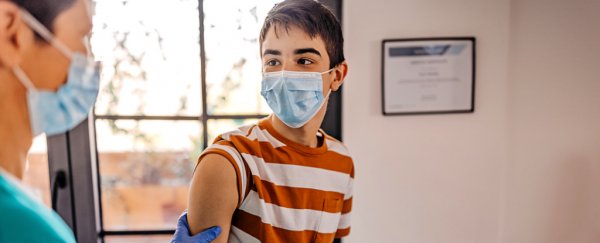The vaccine for human papillomavirus (HPV) is recommended in the United States for all young people up to age 26 to help prevent certain deadly cancers. Today, even though we know both sexes are at risk from HPV-linked cancers, far fewer young men are getting their jabs compared to women.
Analyzing the results of a national health survey between 2010 and 2018, researchers found only 16 percent of men between 18 and 21 years of age reported receiving their first dose of the HPV vaccine. Meanwhile, 42 percent of women in that same age group said they had gotten at least one shot.
Even when accounting for those who got vaccinated after age 18, the survey found less than a third of men received all three doses. For women, it was closer to half.
The study did not examine why this discrepancy exists, but it certainly lines up with traditional messaging around the vaccine. In 2006, the HPV vaccine was first approved in the US to reduce cervical cancer rates, with outreach and education aimed at young female patients.
It took three more years for the FDA to approve the vaccine for anal cancer and penile cancer as well, even though these are also associated with HPV.
Only in 2020 was the vaccine expanded to include the prevention of oropharyngeal cancer, which is more likely to affect men.
"I don't think that a lot of people, both providers and patients, are aware that this vaccine is actually a cancer-prevention vaccine for men as well as women," says head, neck, and throat surgeon Michelle Chen from the University of Michigan.
"But HPV-associated oropharyngeal cancer can impact anyone – and there's no good screening for it, which makes vaccination even more important."
While cervical cancers are dropping significantly among young women in the US, oral cancers, of which 70 percent are caused by HPV, have become one of the fastest-increasing cancers in the world.
The major sex discrepancy in HPV vaccines likely plays a role in that, and not just in the US. It took until 2019 for the United Kingdom to open their free HPV vaccine program to young boys as well as girls.
And it's a good thing they did. Public Health England (PHE) claims this new and improved program will now prevent more than 50,000 non-cervical cancers across the nation by 2058.
In the US, Chen thinks similar advances can be made with a renewed push from pediatricians as well as university health services to recommend the vaccine to both sexes.
In 2019, a study found adolescents who did not have the vaccine recommended by their family physician were close to half as likely to get vaccinated.
"Eighteen- to 21-year-olds are at this age where they're making health care decisions on their own for the first time," says Chen.
"They're in a period of a lot of transition, but young adult men especially, who are less likely to have a primary care doctor, are often not getting health education about things like cancer prevention vaccines."
Other barriers to vaccination include the sheer cost of the vaccine regimen, which can sometimes amount to $450 in the US.
In Australia, where the vaccine is free and available in schools, more than 70 percent of teenage boys and girls are vaccinated and cervical cancers associated with HPV have nearly been eliminated.
The best way to protect everyone from infection, reduce transmission, increase herd immunity and prevent HPV-associated diseases, is to get young people of both sexes vaccinated.
The study was published in JAMA.
